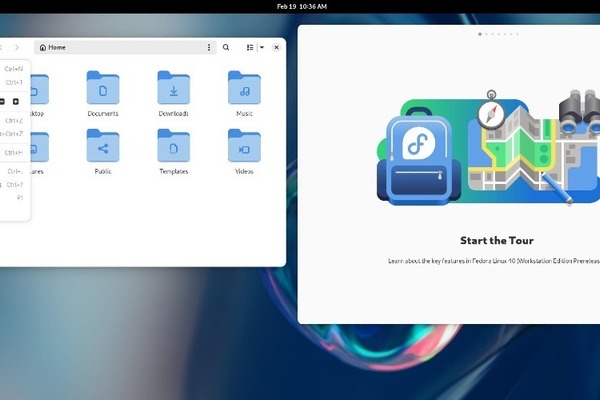2024-07-07 07:01
2024-07-07 07:01
2024-02-07 19:23
2020-02-17 06:34
2024-12-11 17:26
2024-11-02 16:46
2024-09-19 17:27
2019-11-27 17:19
2019-11-11 09:02
2019-07-21 13:03
The release of Inkscape 1.4.2, the first minor release after Inkscape 1.4, brings various fixes, enhancements, and new functionalities.
The update features a new splash screen, initial support for importing Vectornator/Linearity Curve files, a new extension for path cleaning, enhanced import capabilities for Affinity Designer files, 20 fixes for crashes and freezes, over 50 bug fixes, and 14 updated translations. The release notes contain additional information. Inkscape is developed by a dedicated team of volunteers, and users have the opportunity to support the project by engaging with the global community or making a financial contribution.
Kdenlive 25.04.1 has been released, featuring a range of fixes and enhancements. The updates encompass resolving the effect stack layout issue that occasionally hindered access to certain parameters, addressing a crash that occurred when loading multiple clips and switching project profiles, enhancing the speed of audio thumbnail generation, and optimizing memory usage for the automask feature.
The comprehensive changelog outlines several enhancements, including resolutions for audio thumbnail generation, addressing crashes when deleting multiple bin clips, modifications to profiles during clip loading, transitioning from unique_ptr to standard pointers, confirming the python virtual environment is located prior to initiating mask tasks, managing high memory usage of SAM2, AMF checksum adjustments, improvements to the audio mixer volume spinbox, rectifying the release script that was capturing an incorrect version for Kdenlive, enabling the pasting of multi-line text in the notes widget, resolving crashes when moving a single clip from a group or as a standalone clip, and addressing ghost widget and layout concerns within the effect stack.
AnduinOS 1.3, a Linux distribution inspired by Windows 11 and based on GNOME 48, has been updated to version 1.3.1, incorporating minor fixes and enhancements. The tasks encompass addressing Nautilus crashes, modifying image text during boot, incorporating the en_GB locale, rectifying Nautilus admin:/ command errors, and correcting the installer's default fallback order. The update mechanism is currently handled through a bash script but will be integrated into the sudo apt upgrade command in the future.
Here is a roundup of today's reviews and articles:
Cooling: Jiushark JF800 Diamond Review: The best air cooler you can’t buy
Headphones: Corsair Void Wireless v2 Review: A solid mid-range option
Input: Epomaker Alice 66 Review
Memory: TEAMGROUP Triple Threat Review: Ultra MicroSDXC 1TB, CR1 Card Reader, and PU Leather Square Bag, T-FORCE XTREEM 7200 CL34 vs 7600 CL36 vs 6000 CL30 MT/s DDR5 memory kit review
Power: Silicon Power QS58 20000 mAh Power Bank Review
Other: The Razer Iskur V2 overall excels as a gaming chair, but its lumbar support is the true star of the show
GloriousEggroll has released the first Nobara Linux 42 ISO images for testing. The Nobara project is an enhanced iteration of Fedora Linux, featuring modifications tailored for gaming, including WINE dependencies, OBS Studio, third-party codec packages like those for GStreamer, and third-party drivers, such as NVIDIA drivers, among others.
Linus Torvalds has announced the sixth release candidate for Linux kernel 6.15, with a slightly higher number of commits than in rc5, but this is not a significant difference.
The release schedule still has two weeks left, and it seems to be on track. The changes include drivers, architecture fixes, filesystems, core networking, and other random stuff. The changes include enabling InterTouch on various devices, adjusting GPU and NPU clocks in nominal DTSI, fixing pm notifier handling, and improving responsiveness of fbnic_mbx_poll_tx_ready. The kernel also includes fixes for a more liberal vmin/vmax update for freesync, a more liberal call for FP Protect Before Mode Programming/Mode Support, and adjustments to interrupt-controllers for stm32mp25 SoCs and stm32mp21 SoCs. T
ELA-1419-1 wpa security update
RHSA-2025:4787: Moderate: emacs security update
RHSA-2025:4788: Important: redis security update
RHSA-2025:4789: Important: redis security update
Fedora 41 Update: golang-github-nats-io-nkeys-0.4.11-2.fc41
Fedora 42 Update: chromium-136.0.7103.92-1.fc42
Fedora 42 Update: golang-github-nats-io-nkeys-0.4.11-2.fc42
LACT now provides information on OpenCL details, the GPU instruction set version for AMD, and the ROP count for AMD. A new configuration API for GPU settings via the Unix socket has been introduced, enabling the GUI to request confirmation for all configurations. All user interface parts now use the Relm4 library to create GTK UIs, which solves the problems with UI lag that happened after changing settings multiple times, issues that were linked to how GTK handled signals in the old setup.
KDE neon 20250511, based on KDE Plasma 6.3.5, has been released. KDE neon is a Linux distribution built on Ubuntu, featuring the latest version of the KDE Plasma desktop environment.
Here is a roundup of today's reviews and articles:
Casing: XPG Invader X Mini ATX Chassis Review
Graphics Cards: COLORFUL iGAME GeForce RTX 5060 Ti Ultra W OC Review - Style Meets Great Performance
Input: The Stream Deck Neo is surprisingly accessible — if only it were also customizable
Memory: G.Skill Trident Z5 CK DDR5-8800 C42 2x24GB Review: Top-Tier Performance With A Price Tag To Match
Power: ASUS ROG Thor 1000W Platinum III ATX v3.1 PSU Review
Storage: TEAMGROUP T-FORCE A440 Lite M.2 SSD Review - Is This Budget SSD Good?, Patriot Viper PVP30 Portable SSD Review, Sabrent Rocket Enterprise 30.72TB SSD Review - High Capacity and Performance, Samsung T7 2TB USB Type-C SSD Review
Here is a roundup of last week's Linux security updates for AlmaLinux, Debian GNU/Linux, Fedora Linux, Red Hat Enterprise Linux, Rocky Linux, Slackware Linux, SUSE Linux, and Ubuntu Linux.
openSUSE-SU-2025:15072-1: moderate: bird3-3.1.0-1.1 on GA media
openSUSE-SU-2025:15074-1: moderate: libmosquitto1-2.0.21-2.1 on GA media
Fedora 41 Update: php-adodb-5.22.9-1.fc41
Fedora 41 Update: nodejs22-22.15.0-2.fc41
Fedora 41 Update: deluge-2.2.0-1.fc41
Fedora 41 Update: python-h11-0.14.0-7.fc41
Fedora 40 Update: chromium-136.0.7103.92-1.fc40
Fedora 40 Update: php-adodb-5.22.9-1.fc40
Fedora 40 Update: nodejs22-22.15.0-2.fc40
Fedora 40 Update: python-h11-0.14.0-7.fc40
Fedora 42 Update: php-adodb-5.22.9-1.fc42
Fedora 42 Update: deluge-2.2.0-1.fc42
Fedora 42 Update: nodejs22-22.15.0-2.fc42
Fedora 42 Update: python-h11-0.14.0-7.fc42
[ Archive ]









